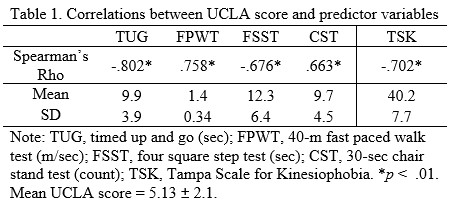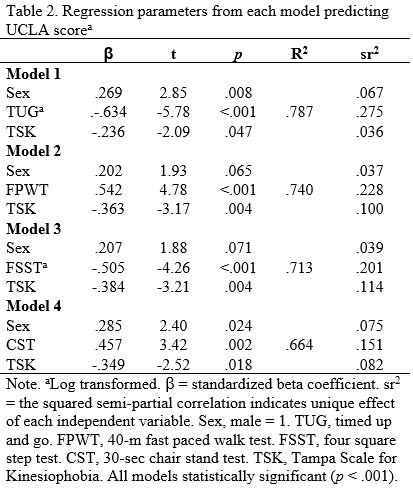Session Information
Session Type: Poster Session A
Session Time: 8:30AM-10:30AM
Background/Purpose: Only a small proportion of people with knee osteoarthritis (OA) meet the recommended guidelines for physical activity and it is still unclear why. Lacking regular participation in physical activity is a risk factor for functional limitations in people with knee OA. Psychological factors, such as kinesiophobia (fear of movement), have been linked to activity avoidance behaviors in this population. The purpose of our study was (i) to investigate the effects of selected physical function measures in explaining physical activity, and (ii) to determine whether kinesiophobia may contribute to activity level beyond what is explained by physical function measures.
Methods: Thirty participants (16F | 14M; age, 40-75 y) with doctor diagnosed uni- or bilateral knee OA consented to participate in this cross-sectional study. Physical activity was assessed by self-report using the UCLA activity rating scale (1-10, inactive to regular participation in impact sports). Physical function was assessed using the four square step test (FSST), 30-sec chair stand (CST), timed up and go (TUG), and 40-m fast paced walk (FPWT). These performance-based measures were selected because they assess different domains of physical performance and functional ability. The Tampa Scale for Kinesiophobia (TSK; scale 17-68, no fear to extreme fear of movement) was used to assess the degree of kinesiophobia. We used Spearman correlations and multiple regression analysis to examine the relationships between UCLA activity scores and the predictors. Separate regression models were calculated for each physical function measure, in which TSK score and the covariate sex were the other independent variables, and UCLA score was the dependent variable in all models. Alpha was set at p < 0.05 for all analyses. Prior to parametric analysis, data were transformed when necessary, using logarithmic transformations.
Results: Better performance on all physical function measures and lower TSK scores (less fear) were associated with higher self-reported activity levels (Table 1). Regression models significantly accounted for 66.4% to 78.7% of the variance in UCLA scores (Table 2). Better performance on all functional measures predicted higher UCLA scores after controlling for sex and TSK. Lower TSK score (less fear) was a significant predictor of higher UCLA scores in all models after accounting for physical function and sex. Physical function measures were the most important predictors of UCLA scores in each model, uniquely explaining 15.1% to 27.5% of the variation in UCLA scores. However, TSK score uniquely explained 3.6% to 11.4% of the variation seen in UCLA scores.
Conclusion: Physical function measures were associated with UCLA scores, however kinesiophobia also contributed to explaining physical activity level even after accounting for physical function and sex. Assessing both kinesiophobia and physical function could help clinicians better identify knee OA patients that may be prone to avoiding certain activities or exercises.
To cite this abstract in AMA style:
Aydemir B, Foucher K. Effects of Kinesiophobia and Physical Function on Physical Activity in Adults with Knee Osteoarthritis [abstract]. Arthritis Rheumatol. 2021; 73 (suppl 9). https://acrabstracts.org/abstract/effects-of-kinesiophobia-and-physical-function-on-physical-activity-in-adults-with-knee-osteoarthritis/. Accessed .« Back to ACR Convergence 2021
ACR Meeting Abstracts - https://acrabstracts.org/abstract/effects-of-kinesiophobia-and-physical-function-on-physical-activity-in-adults-with-knee-osteoarthritis/


